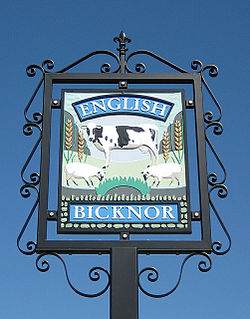English Bicknor
| English Bicknor | |
| Gloucestershire | |
|---|---|
 Village sign | |
| Location | |
| Grid reference: | SO581156 |
| Location: | 51°50’17"N, 2°36’32"W |
| Data | |
| Population: | 408 (2011) |
| Post town: | Coleford |
| Postcode: | GL16 |
| Dialling code: | 01594 |
| Local Government | |
| Parliamentary constituency: |
Forest of Dean |
| Website: | www.englishbicknor.org.uk |
English Bicknor is a village and parish in the Forest of Dean in west Gloucestershire. According to the United Kingdom Census 2001 the population was 406, increasing marginally to 408 at the 2011 census.[1] The village is close to the county border with Herefordshire, opposite which is the village of Welsh Bicknor. The two towns lie on different sides of the River Wye.
The existence of Bicknor is documented as far back as the Domesday Book of 1086, when it was known by the name Bicanofre. The second morpheme of this name, ōfer, is thought to refer to a river bank in Old English, which jibes with the towns' river-straddling site. Various hypotheses have been put forward regarding the origin of the first morpheme in the name.
History
English Bicknor is one of the ancient villages of the Forest of Dean, situated at the top of a hill overlooking the Wye Valley, and once the site of a motte-and-bailey castle, the remnants of which can still be seen. Close to the village is Bicknor Court, an imposing house some 400 years old. Situated between Symond's Yat and Lower Lydbrook on high ground opposite its namesake Welsh Bicknor. English Bicknor is first recorded as a hamlet in 1066.
A primarily agricultural and industrial area, its main attraction today is the small Norman parish church dedicated to St Mary which has excellent internal stonemasonry and sculpture dating from the 12th century. The original tower was situated centrally but was built from the soft local sandstone which became unsafe. The church is also interesting because it is sited within the outer courtyard of the motte and bailey castle. Norman masonry has been found within the motte, suggesting at least part was built in stone and while nothing is left of the castle's actual structure today, its location is still identifiable. A typical early Norman defence work which is one of many along the Welsh Marches, it is thought to have been built in the reign of Henry I (1100–1135) or King Stephen (1135–54) and was demolished or destroyed by the late 14th century, but why and how is not known (possibly during the rebellion of Owain Glyndŵr).
St Mary's Church
The present day church is Norman dating to AD 1100 and is set in an oval churchyard of Anglo-Saxon origin within the outer courtyard of a Norman motte-and-bailey castle. The exterior walls, renewed in Victorian times, offer no clue to the Norman building work within. Only the exterior stonework of the 13th century west tower is original. Inside the church, the four bay north arcade and five bay south arcade are both Norman, but interestingly have different decoration around the capitals. The church had a central tower before the current west tower was built. The interior of the church is dominated by Romanesque pillars and contains a flat tomb with a rare example of Lombardic script which is dated to c. 1420. This translated means "Pray for the soul of our departed brother in Christ".
The font is Norman, and amongst the treasures of the church are three stone figures representing church monuments. Cecilia Muchegros, who lived in the village and died in 1301, and Hawisia, who died in 1353 and whose figure is dressed in a long flowing robe, both have dogs at their feet. The third figure is of a priest, with an old body and a young head. It is not known who he was, but may have been the priest in the church in the early 14th century. Other objects of notable interest include stained glass by Percy Bacon from 1908.
References
- ↑ "Parish population 2011.Retrieved 26 March 2015". Archived from the original on 2 April 2015. https://web.archive.org/web/20150402101214/https://neighbourhood.statistics.gov.uk/dissemination/LeadKeyFigures.do?a=7&b=11123228&c=English+Bicknor&d=16&e=62&g=6427198&i=1001x1003x1032x1004&m=0&r=1&s=1427386506536&enc=1.
Outside links
| ("Wikimedia Commons" has material about English Bicknor) |